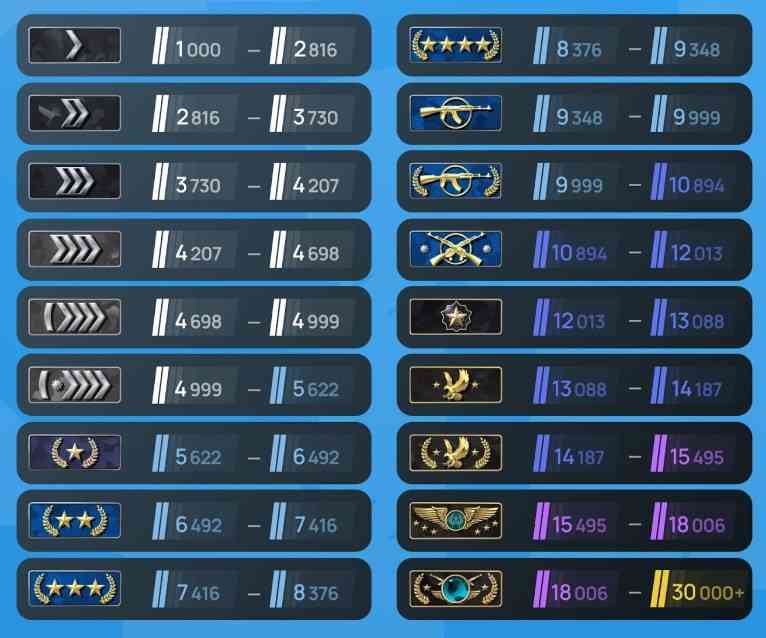Bridal Bliss Insights
Your go-to blog for all things weddings, trends, and bridal elegance.
From Silver to Global: Bizarre Myths About CSGO Ranks
Uncover the wildest myths surrounding CSGO ranks! Dive into the bizarre truths that go beyond Silver to Global and boost your gaming knowledge!
Exploring the Most Outlandish Myths Surrounding CSGO Ranks
In the competitive world of CSGO ranks, players often find themselves entangled in a web of myths that can mislead even the most seasoned veterans. One popular myth is that purchasing skins or other cosmetic items can somehow influence a player's rank. However, this notion is entirely baseless; the game's ranking system is based on performance metrics, including kill-death ratio and win-loss records, rather than the market value of virtual skins. Understanding CSGO ranks requires separating fact from fiction and recognizing that skill is the only determinant of success.
Another outrageous myth suggests that playing with a higher-ranked friend can automatically boost your own rank, a phenomenon often referred to as 'boosting.' While it's true that playing with skilled teammates can improve your gameplay experience, it does not directly translate into a rank increase. CSGO uses a sophisticated matchmaking system designed to fairly assess individual performance and ensure that rank appropriately reflects skill level. Therefore, trusting in myths instead of honing your skills could hinder your progress in the competitive arena of CSGO ranks.

Counter-Strike is a popular tactical first-person shooter that emphasizes teamwork and strategy. One of the notable weapons in the game is the aug, which is favored by players for its accuracy and versatility. Players can choose between different modes and maps, making each game unique and thrilling.
Do CSGO Ranks Really Affect Your Gameplay? Debunking Common Misconceptions
In the world of CSGO ranks, many players believe that their rank directly influences their overall gameplay experience. However, this misconception oversimplifies the complex dynamics of skill and performance in the game. While it's true that higher ranks generally signify better mechanical skills and game sense, a player's rank does not always determine their in-game effectiveness. Factors such as teamwork, communication, and individual adaptability often play a more significant role in determining the outcome of a match. For instance, a low-ranked player who excels at strategic plays and team support can significantly impact the game, challenging the belief that ranks alone dictate performance.
Another common myth is that playing with teammates of significantly different ranks will inevitably lead to negative results. However, this isn't necessarily the case. Many players find that team synergy and collaboration can bridge the skills gap, resulting in a more cohesive and effective team dynamic, regardless of varying ranks. Indeed, when players focus on mutual learning and communication, they can overcome rank disparities. In conclusion, while CSGO ranks can provide a general understanding of a player's skills, they should not be viewed as the sole predictor of gameplay success. Understanding the multifaceted nature of gameplay can enhance player experiences and promote a healthier gaming environment.
From Silver to Global: What Are the True Requirements for Each Rank?
Advancing through various ranks in any organization often involves navigating a set of requirements that vary significantly from one level to the next. At the Silver rank, individuals typically focus on mastering fundamental skills and establishing a strong team presence. Requirements often include achieving specific performance metrics, such as sales targets or project completions, and demonstrating effective collaboration with peers. Additionally, building a solid personal brand within the company and actively participating in team activities is essential for moving to the next rank.
As professionals progress to the Global rank, the requirements become increasingly complex and demanding. At this level, individuals are not only expected to meet aggressive performance metrics but also to exhibit leadership qualities and strategic thinking. This may include:
- Leading cross-functional teams across multiple regions
- Developing innovative solutions that drive company growth
- Mentoring junior team members to foster talent
- Contributing to the organization’s global vision and strategic goals
Ultimately, the journey from Silver to Global is marked by a continual evolution of skills, mindset, and contributions to the larger organizational objectives.